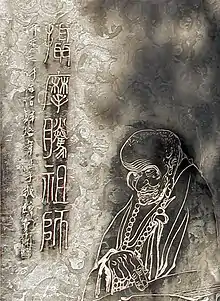Kasyapa Matanga
Kasyapa Matanga (Kāśyapa Mātaṇga) or Jia Yemoteng 迦葉摩騰 (Jia Shemoteng 迦攝摩騰, Zhu Yemoteng 竺葉摩騰, or Zhu Shemoteng 竺攝摩騰) was an Indian Buddhist monk who is traditionally believed to have first introduced Buddhism to China in the 1st century CE.[2]
Kāśyapa Mātaṇga | |
|---|---|
 Tumulus marker of Kāśyapa Mātaṇga located in White Horse Temple, Luoyang, China | |
| Personal | |
| Born | unknown Central India[1] |
| Died | 73 CE |
| Religion | Buddhism |
| Notable work(s) | Sutra in Forty-two Sections |
| Occupation | Buddhist monk who introduced Buddhism to China, translator from Sanskrit to Chinese |
| Part of a series on |
| Chinese Buddhism |
|---|
 Chinese: "Buddha" |
| Kasyapa Matanga | |||||||||
|---|---|---|---|---|---|---|---|---|---|
| Chinese name | |||||||||
| Traditional Chinese | 迦葉摩騰 | ||||||||
| Simplified Chinese | 迦叶摩腾 | ||||||||
| |||||||||
| Sanskrit name | |||||||||
| Sanskrit | काश्यपमातण्ग | ||||||||
According to popular accounts of Chinese Buddhism, Emperor Ming of Han dreamt of a golden deity interpreted as the Buddha and sent a delegation to India. They returned circa 67 CE with the monks Kasyapa Matanga and Dharmaratna, and white horses carrying Buddhist texts and images. The emperor established White Horse Temple in the Han capital Luoyang, where the two supposedly first translated the Sutra of Forty-two Chapters into Chinese.[3]
References
- Ludvik, Catherine (2007). Sarasvatī, Riverine Goddess of Knowledge: From the Manuscript-carrying Vīṇā-player to the Weapon-wielding Defender of the Dharma. Brill. p. 150. ISBN 9789004158146.
- Julch, Thomas (2016). The Middle Kingdom and the Dharma Wheel: Aspects of the Relationship between the Buddhist Saṃgha and the State in Chinese History. Brill. p. 47. ISBN 9789004322585.
- 迦葉摩騰, Digital Dictionary of Buddhism (login: guest, no password).
This article is issued from Wikipedia. The text is licensed under Creative Commons - Attribution - Sharealike. Additional terms may apply for the media files.